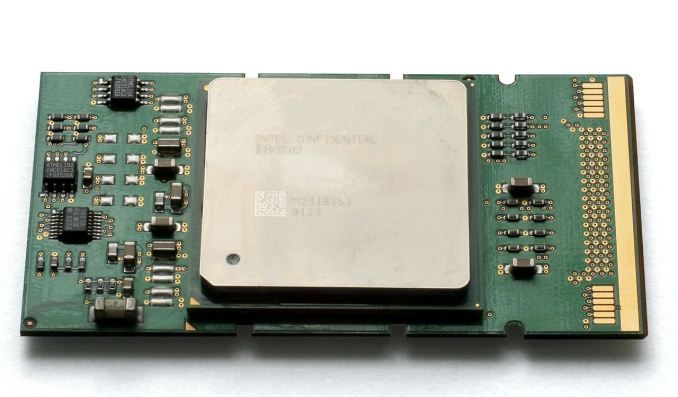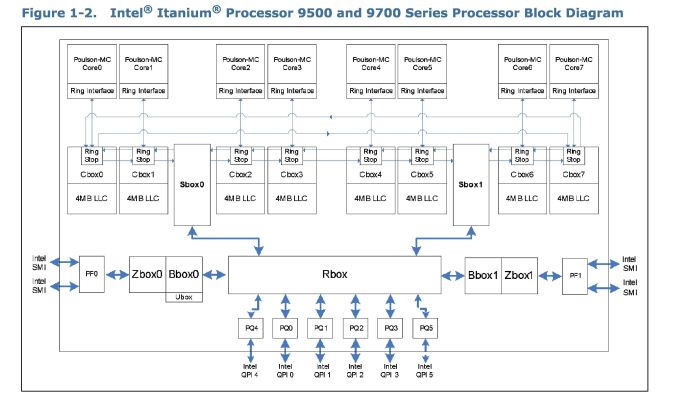Intel’s Itanium Takes One Last Breath: Itanium 9700 Series CPUs Released
by Ian Cutress on May 11, 2017 11:10 AM EST- Posted in
- CPUs
- Intel
- Itanium
- Enterprise
- Enterprise CPUs
- IA-64
- Kittson

One of Intel’s ventures into the historic mainframe space was Itanium: a 64-bit capable processor designed in conjunction with Hewlett Packard. The main reason for Itanium was to run HP-UX and compete against big names, such as Oracle, using a new IA-64 instruction set. The appeal for the original Itanium parts was support for RAS features, ECC, and cores focus on a wide, parallel architecture - the latest cores support 12-wide execution for example. For a short while, there was success: HP’s systems based on Itanium are advertised as high-uptime mission critical servers, and a number of customers cling to these systems like a child clings to their favorite blanket due to the way they are integrated at the core of the company. The main purpose was to compete against other mission critical servers and mainframes based on SPARC and IBM Power.
So when the processors were initially delivered to customers, there was potential. However the initial impression was not great - they consumed too much power, were noisy, and needed over the top cooling. Over the years and generations of Itanium, the march into the x86 enterprise space with x86-64 drew potential Itanium customers away, then followed the drop of Microsoft's support for Itanium in 2008, and Oracle's dropped support in 2011. Xeon offerings were becoming popular, with CPUs incorporating the RAS/ECC features required, and Intel decided to slow down Itanium development as a result. In the meantime, due to the way the market was moving, HP transitioned a good part of its product stack to Xeons. Despite this, legal battles between HP and Oracle ensued given predicted support for HP-UX customers. At this point, there were fewer potential Itanium customers each quarter, although existing customers required support.
Today marks the release of the final known variant of Itanium, the 9700 series, beyond assurance testing. Intel spoke to IDG, stating that this generation, code-named Kittson, would be the final member of the Itanium family. These chips are likely to only end up in HP-based Integrity i6 high-uptime servers running HP-UX, and start at $14500. Hewlett Packard Enterprise has stated previously that it will keep support for Itanium-based products until 2025, with the latest OS update (HP-UX 11i v3 2017) coming in June.
As for the processors themselves, four 9700 processors form the stack, with quad-core and eight-core parts all with hyperthreading, differing in frequency, power, and L3 cache.
| Intel Itanium (Kittson) CPUs | |||||
| Cores/ Threads |
Base Freq |
L3 | TDP | Cost* | |
| Itanium 9760 | 8/16 | 2.66 GHz | 32 MB | 170 W | $4650 |
| Itanium 9750 | 4/8 | 2.53 GHz | 32MB | 170W | $3750 |
| Itanium 9740 | 8/16 | 2.13 GHz | 24 MB | 170 W | $2650 |
| Itanium 9720 | 4/8 | 1.73 GHz | 20 MB | 130 W | $1350 |
*Cost is listed for the equivalent Poulson CPUs.
The base silicon comes in at 3.1 billion transistors, and are made on Intel’s 32nm process. Memory is supported up to DDR3-1067, with two memory controllers but support for scalable memory buffers is present. This is similar to the 9500 series, code-named Paulson. These chips are designed to be purely a drop into previous systems. Intel isn’t announcing an official press release around this, and unlike other ‘new architectures’, there are next to zero improvements. According to the documents, the only change is that the top two SKUs get a clock bump:
There’s probably something new under the hood, perhaps for a specific end-customer, but at this time Intel is directing anything 9700 related to equate to the 9500 series. Customers still interested in Itanium are directed to HPE resellers.
Carousel Image from Konstantin Lanzet (Wikipedia) of Itanium 2 (Poulson)
News Source: IDG













50 Comments
View All Comments
SarahKerrigan - Thursday, May 11, 2017 - link
Just to clarify - I'm fully aware IPF wasn't shipping thirty years ago, but R&D started around then (as PA-WideWord/Super Workstation). It was a long, hard road from there to Merced shipping (and landing with a resounding thud.)mode_13h - Friday, May 12, 2017 - link
Huh. I was sure I'd read about another generation of PA-RISC CPUs, just a few years ago.Well, they were good in their day. I always remember them posting up some of the top SPEC numbers.
mode_13h - Friday, May 12, 2017 - link
For me, the interesting "what if" isn't if Itanium had better support, but if Intel hadn't killed Alpha and (indirectly) PA-RISC. x86-64 would still probably end up ruling the cloud, but maybe we'd have Alpha-powered cell phones?SarahKerrigan - Friday, May 12, 2017 - link
Alpha had issues of its own. The Alpha 21364 was way ahead of everyone else in uncore (well, except K8, which got an IMC and a point-to-point SMP interconnect around the same time) but the ISA had its share of nastiness, especially prior to BWX.PA-RISC didn't *die*, exactly. IPF was always intended by HP to be PA's evolution, and shares a lot of design concepts (relatively compact cores in sea of cache, no integer multiply...). IPF was a combination of PA design concepts with a massive bet on in-order processors with some degree of static scheduling being the future.
As it turned out, it wasn't.
Meteor2 - Friday, May 12, 2017 - link
I find ISA family trees fascinating. What we're left with is the product of natural selection; the weak have died and the strong thrived. I'm always surprised SPARC is still with us; I doubt that any organisation that feels it needs to be using SPARC is taking the optimal approach to meet its requirements. At least POWER is a cracking platform for VMs.mode_13h - Friday, May 12, 2017 - link
Well, SPARC is open. I don't know how much that has to do with it.It's a shame to see POWER fall behind x86-64. I wonder if it'll ever regain the performance crown.
SarahKerrigan - Friday, May 12, 2017 - link
SPARC is "open" only in a very limited sense. The last open-source core was the T2, which is a decade old (and fairly mediocre at the time.)Power9 should do just fine against SKL-SP. Power8 beat Intel regularly early in its lifecycle. I wouldn't say it's fallen massively behind - on SPEC, 12-core P8 behaves similarly to 24-core Broadwell-EX iirc (both in the 900-950 per socket range on int_rate)
mode_13h - Saturday, May 13, 2017 - link
I wasn't talking about open source. Just that it's an open standard. See http://sparc.orgAs for POWER8, I had these in mind:
http://www.anandtech.com/show/9567/the-power-8-rev...
http://www.anandtech.com/show/10539/assessing-ibms...
...where it seemed pretty clear that Power8 was less efficient than comparable Intel offerings.
SarahKerrigan - Saturday, May 13, 2017 - link
The second review shows P8 being more efficient, at least at MySQL, than Haswell-EP. For a 22nm CPU toward the end of its life (remember, Power8 has been around since 2014!), that isn't a bad place to be. My company runs some P8 and we're pretty happy with it.On raw performance, that isn't anywhere close to the high end of Power8, which is the "Venice" SCM family used in the big E870/E880 systems - these chips top out at 12-core, 4GHz. What OpenPower gets is "Turismo", which is lower-binned "Venice" with lower clocks and half their memory controllers disabled.
willis936 - Saturday, May 13, 2017 - link
Or low speed embedded systems that have sub 20 cycle memory. Don't forget that there are still more microwaves than servers.